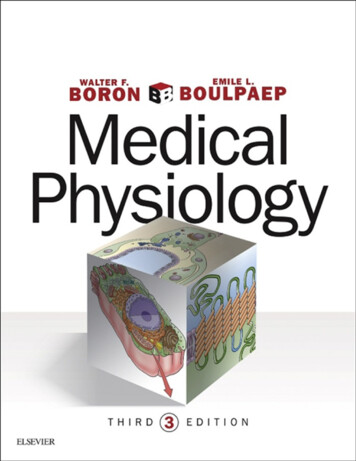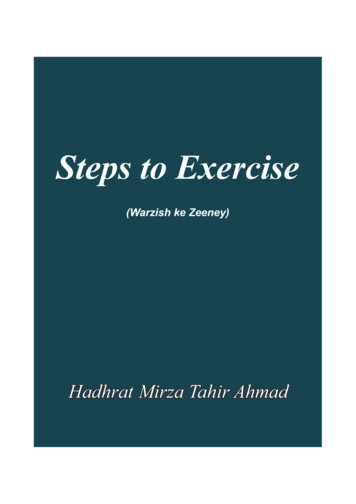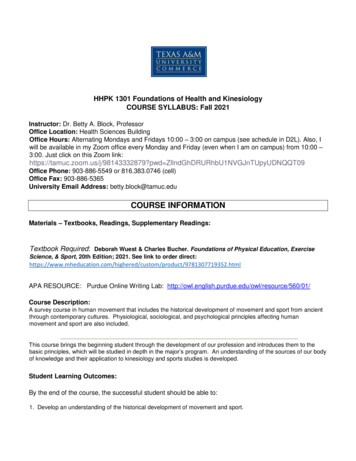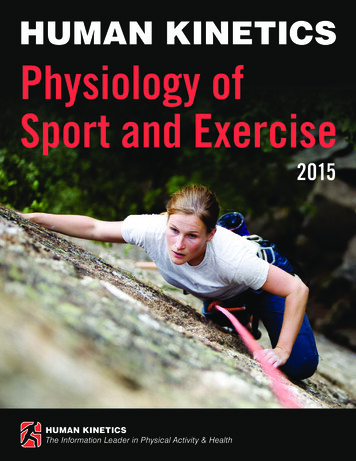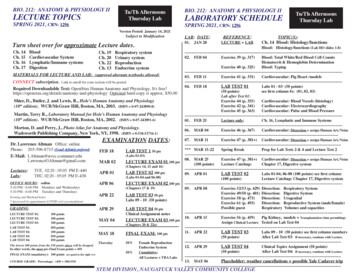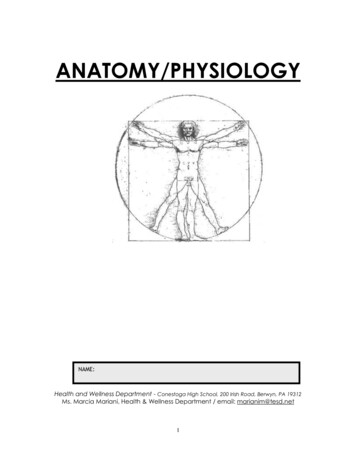
Transcription
Dr. Robert RobergsFall, 2010What is Exercise Physiology?Robert A. Robergs, Ph.D., FASEP, EPCProfessor: Exercise Physiology &BiochemistryExercise Science ProgramDepartment of Health, Exercise & SportsSciencesCollege of EducationUniversity of New MexicoWhat is Exercise Physiology?1. An Academic Program of Study, and a Coursein Exercise ScienceThe study of how exercise and physical activityalters the structure and function (physiology) ofthe human body.2. A ProfessionA profession of appropriately trained individualswho have studied a suitable curriculum within theexercise sciences, with an emphasis in exercisephysiology.PEP426-Intro & History1
Dr. Robert RobergsFall, 2010Development of Exercise PhysiologyBeginnings ? - 1960Era of Sports and Athletics . 1960 - 1980Era of Medical Awakening 1970 - presentPresent Status of Exercise PhysiologyResearch and Knowledge 1990 - presentBeginnings ? - 1960, cont’d.In early history, fitness was synonymouswith survivalAncient EgyptAncient GreecePEP426-Intro & History1
Dr. Robert RobergsFall, 2010Beginnings ? - 1960, cont’d.Archibald V. Hill: “maximal oxygen consumption”“In running the oxygen requirement increasescontinuously as the speed increases, .; theactual oxygen intake, however, reaches amaximum beyond which no effort can drive it.The oxygen intake may attain its maximum andremain constant merely because it cannot go anyhigher owing to the limitations of the circulatoryand respiratory system.”Archibald Vivian HillPEP426-Intro & History(Hill A.V. and H. Lupton. QQ J Med 1923; 16:135-171.)1
Dr. Robert RobergsFall, 2010Beginnings ? - 1960, cont’d.Harvard Fatigue Laboratory 1927-1947David Bruce Dill (Director)Initial research focused onhow different occupationsaffected the body,environmental physiology(altitude,dry, moist heat),metabolism during exerciseand aging, blood gastransport, acid-base balance,and nutritionMay 6, 1954(Iffley Road, Oxford, England)Roger Bannister crossingthe finish line for the milein 3:59.4PEP426-Intro & History1
Dr. Robert RobergsFall, 2010Physical Education HeritagePEP426-Intro & History1
Dr. Robert RobergsFall, 2010Era of Sports and Athletics. 1960 - 1980Research progressed to applied questions thatconcerned exercise. Diet, exercise and muscle glycogen Metabolic demands of differing exercise intensities Determinants of exercise performance Effects of training on function and performance Exercise in various environmentalconditions What strategies delay fatigue?Era of Medical Awakening, 1970 - presentPEP426-Intro & History1
Dr. Robert RobergsFall, 20101980’sPhysicians hooked on exercise: Kenneth Cooper &George SheehanCovert Bailey: “If exercise could be packaged into apill, it would be the most prescribed medication in all ofhistory”.The benefits of exercise training on the following wasrecognized: Health Promotion & Quality of Life Blood lipids Heart Function in Diseased Populations Disease Prevention & RehabilitationCHD, PVD, COPD, Hypertension, Diabetes, Obesity, Cancers,Depression/Mood States, .Medical-Pharmaceutical Complex StillStruggling With Exercise & DiseasePreventionhttp://www.youtube.com/watch?v xsuK7BeOyvQPEP426-Intro & History1
Dr. Robert RobergsFall, 2010Present Status of Exercise Researchand Knowledge . 1990 - present Role of exercise in supporting body functions inmicrogravity Exercise in special populations: disabled, elderly,children, pregnant women, etc. Development of new equipment, technologies andtechniques: stable isotopes (substrate use and cellularmetabolism); magnetic resonance imaging andspectroscopy (muscle metabolism and blood flow)PEP426-Intro & History1
Dr. Robert RobergsFall, 2010NASA &Exercise PhysiologyExercise Physiology is the UltimatePhysiological ScienceCONTENTAPPLICATIONMetabolic onNeuromuscularBody CompositionCalorimetryPharmacologyHealth and DiseaseExercise Testing and PrescriptionPEP426-Intro & HistoryExercise ModesExercise IntensitiesFitness ComponentsEnvironmentsSpecial PopulationsAgeSexDiseaseEliteSportsAthletics1
Dr. Robert RobergsPEP426-Intro & HistoryFall, 20101
Dr. Robert RobergsPEP426-Intro & HistoryFall, 20101
Dr. Robert RobergsFall, 2010What is Clinical Exercise Physiology?A sub-component ofexercise physiology thatinvolves the applicationof exercise physiologyprinciples, knowledgeand skills for purposesof the rehabilitation ordiagnosis of disease ordisability in humans.PEP426-Intro & History1
Dr. Robert RobergsFall, 2010U.S. Health Status 5 leading causes of death population 65 years overweight adults obese adults -Heart, Cancers, stroke,COPD, unintentional12%65%28% highest obesity by race -50% Non-Hispanic black women adult men and women who are inactive -22% Men; 28%Women New Mexico’s ranking for raising children - 48th population 65 years with no health insurance - 16% HS students not enrolled in PE - 53%Obesity Trends* Among U.S. AdultsBRFSS, 2007(*BMI 30, or 30 lbs. overweight for 5’ 4” person)No DataPEP426-Intro & History 10%10%–14%15%–19%20%–24%25%–29% 30%1
Dr. Robert RobergsFall, 2010New Frontiers in Exercise PhysiologyIn the future an exercise physiologist will be requiredto master the following: broad pure science academic base(molecular biology, biochemistry, neurophysiology,cardiology, pulmonary physiology, endocrinology) broad applied academic base (body composition,exercise prescription, athletic/sport training) sophisticated equipment & technologies superior research skillsProfessional IssuesPEP426-Intro & History1
Dr. Robert RobergsFall, 2010ASEP EPC ExamExercise Physiology Research JournalsJournalActa Physiologica ScandinaviaAmerican Journal of Physiology (APS)Canadian Journal of Applied SportsSciencesEuropean Journal of Applied PhysiologyInternational Journal of Sports MedicineInternational Journal of Sports NutritionJournal of Applied PhysiologyPEP426-Intro & History1
Dr. Robert RobergsFall, 2010JournalJournal of Exercise Physiologyonline (ASEP)Journal of PhysiologyJournal of Sports Medicine and Physical FitnessJournal of Strength and Conditioning ResearchMedicine and Science in Sports and Exercise(ACSM)Professionalization of Exercise Physiologyonline(ASEP)Research Quarterly For Exercise and SportSports MedicinePEP426-Intro & History1
International Journal of Sports Nutrition Journal of Applied Physiology Exercise Physiology Research Journals. Dr. Robert Robergs Fall, 2010 PEP426-Intro & History 1 Journal Journal of Exercise Physiology online (ASEP) Journal of Physiology Journal


